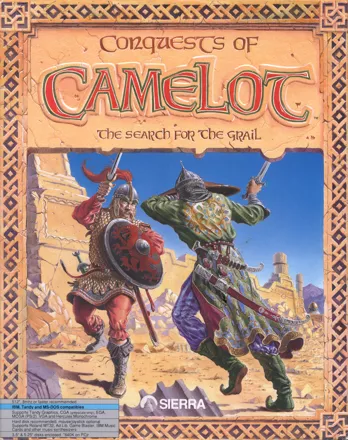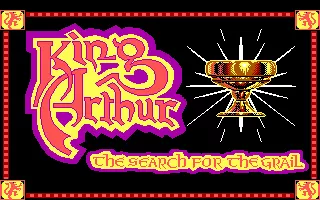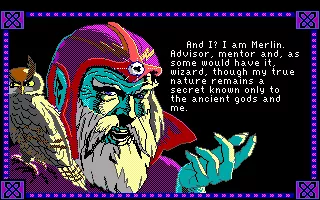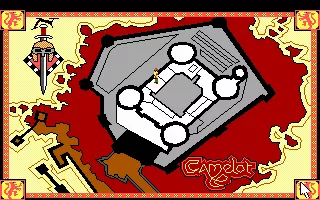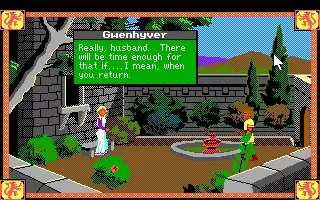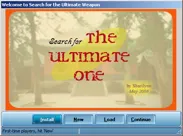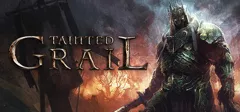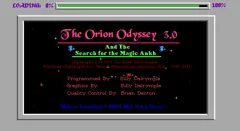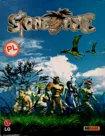Conquests of Camelot: The Search for the Grail
Description official description
It is the ninth century, and Camelot, the legendary castle ruled by King Arthur, has fallen under a curse. Famine and drought plague the kingdom because of the love triangle between the king, his wife Gwenhyver, and the knight Launcelot. It appears that only the mysterious Holy Grail can restore Camelot, and three knights - Launcelot, Gawaine, and Galahad - embark on a journey to find it, and soon disappear without a trace. King Arthur leaves his castle in search of the missing knights, hoping to locate the Grail as well. His quest takes him to real and mythical locations in England, and later to Jerusalem and other areas of the Holy Land.
Conquests of Camelot is an adventure game that requires the player to input text commands, mostly by combining verbs and objects (such as "look man", "take purse", etc). A few commands (such as "ask about") have keyboard shortcuts. Unlike most other adventures, the game does not focus extensively on inventory-based puzzles. Rather, it presents a diverse array of tasks depending on concrete situations. These involve exploration, solving riddles, gathering information, participating in arcade sequences such as jousting, and others. Rudimentary money management is present as well.
Many problems have different solutions, and it is possible to reach the final part of the game even without having completed some of the essential quests (e.g. failing to save the knights). However, Arthur is being judged by the game in three different categories: skill (referring to the action sequences), wisdom (evaluating the amount of cultural information gathered), and soul (determining the moral value of Arthur's action). Failure to achieve a high score in the last category leads to a bad ending.
The game is set in a concrete historical period, but adds an alternate reality to it, assuming that pagan deities really existed, but were overshadowed by Christian worship. However, there are only a few references to real religious practices of the time or any historical characters.
Groups +
Screenshots
Videos
Add Trailer or Gameplay Video +1 point
See any errors or missing info for this game?
You can submit a correction, contribute trivia, add to a game group, add a related site or alternate title.
Credits (DOS version)
35 People (34 developers, 1 thanks) · View all
| Executive Producer | |
| Game Designer | |
| Art Designer | |
| Producer | |
| Lead Programmer | |
| Composer | |
| Documentation | |
| Documentation Art | |
| Animators | |
| Background Artists | |
| Programmers | |
| Development System | |
| [ full credits ] | |
Reviews
Critics
Average score: 75% (based on 14 ratings)
Players
Average score: 3.7 out of 5 (based on 63 ratings with 7 reviews)
By far one of the most beautiful adventure games I've ever played...
The Good
Everything from the music to the graphics (though limited to 16 colors, the game had real artistic talent behind the sprites and the animations) was fantastic.
The game features a lovely mix of action and adventure. The action elements aren't a main focus in the game and aren't too involved (think Space Quest), so people who love adventure games shouldn't be turned off.
The puzzles in the game can be challenging but I managed to get through the whole game without being really stuck more than once. The only time I got stuck was a part that involved yelling, which was an action you didn't have to do at any other point in the game.
The game also has multiple endings based on some of the decisions you make, just like with Conquest of the Longbow (another exquisite adventure game).
Someone mentioned the riddles in the game as a bad part. For me, they were some of the most interesting puzzles in the game. The riddles are masterfully written in a way that anyone should be able to solve them given enough time and thought. I first played the game when I was 13 and managed to solve every riddle I encountered, and I played the riddles section multiple times to see every riddle. Anyway, some people might be turned off and may want to immediately progress to the next section. For those people, the riddles might have been pretty frustrating.
The Bad
I didn't like the part in the game where I got stuck. Like I mentioned earlier, it involved yelling which was something you didn't have to do throughout the whole game up until then, so I never even thought to try it. I imagine lots of people got stuck on the same part for the same reason.
Every single puzzle is still very logical. Unlike too many games, there's no brute force strategy to figuring out what to do where you run into parts where you have to just try every single action you can think of with no sense of direction. Looking around each environment gives clues as to what you do, and just about everything should be obvious. If not, you'll probably hit yourself on the head when you figure it out because the game really does a great job of filling you in.
The copy protection puzzles are probably the most annoying thing. I didn't even think to look in the manual when I first played the game with the riddle of the flowers.
The Bottom Line
I would say this is one of the greatest adventure games ever made, not just for aesthetic reasons (though it certainly is among the best in this department as well), but for the straight-forward adventure gameplay with some entertaining action moments.
To me, Quest for Glory, Conquest of Camelot, and Conquest of the Longbow offer the best Sierra has to offer when it comes to the adventure department because they offer some of the most straight-forward (but not necessarily easy) puzzles, often with multiple approaches.
DOS · by John Lucas (12) · 2005
An innovative, parser-based Sierra adventure.
The Good
The feature that most distinguishes Conquests of Camelot from other Sierra games of the period is that you (via King Arthur, your in-game cypher) are required to partake in many more challenges than simply solving item-manipulation puzzles. At one point you must slay wild boar; at another, you're dueling with a saracen; at still another, you're jousting. This, coupled with a fairly logical puzzle system, makes Conquests of Camelot a gem worth seeking out if you can configure your system to support it.
The Bad
The one feature that is guaranteed to irritate a fair number of gamers are the riddles. At one point, Arthur must solve a number of riddles to advance. If you cannot answer even one, you're stuck. Luckily, the riddles themselves rotate, so if you're stuck on one, leave the screen and return to get a new, possibly easier one.
The Bottom Line
King Arthur must venture out to recover the Holy Grail. Along the way, he undergoes a variety of challenges, physical, mental and spiritual, that make up the core of the gameplay. Imagine King's Quest with combat and a semi-historical flavoring and you've got the core of Conquests of Camelot.
DOS · by Lucas Schippers (57) · 2001
One of the best Sierra games ever, makes you forget it's EGA
The Good
A review I read before buying, said the game was the best production of Sierra for 1990. I realised why.
The game can stand next to each other Sierra games and be judged as superior, almost for all its aspects. It's a real, serious, epic production, encompassing many elements that will satisfy the player. There is much travelling to many places, battles, choices to be made (affecting the course of the play), and much lore.
The graphics are really exceptional compared to the main corpus of Sierra. The sprites are richly animated, and there is much interaction with them (eg. you can kiss Gwynevere before leaving). The introductory scenes are well drawn, and resemble those that will be used in the cutscenes, much later in the Sierra VGA games.
The game is really atmospherical. Not only due to the graphics (I noted some anachronisms), but mainly because of the descriptions and dialogues. The messages are not the 'narrator's speech', but Merlin who communicates with you telepathically. All descriptions are supposedly personal views and knowledge of Merlin. Some scenes contain many objects and if you examine them, you will get immersive folkloric knowledge.
Interactivity is also rich. Almost everything you will try (like the F... word to people) will give you Merlin's appropriate reply. The designers have tried to predict as much of your thoughts as possible, often surprising you.
The game design also presents some differences. Here it's not easy to overlook something needed much later. Some choices you can make (Eg. not saving Lancelot, or giving the hag money instead of the artifact she wants) will affect something much later, but they are things that you know they are wrong, made only deliberately. In cases you will overlook or lose an artifact, its use would be only to make your life easier. The point where you will need it, you can also pass by trial and error
The soundtrack is one of the first I loved in games. I remember myself recording medieval melodies in my tape recorder!! So atmospheric that will put you in the position you should be. Medieval Britain, or the oriental Jerusalem, themusic is what you want to hear to put you in Arthur's shoes.
Last but not least, the package of the game is also one of the best I have seen. The box is beautifully drawn. It contains an also beautiful map of Europe (I am not not to decide it's historical accuracy), and an also beautiful manual, book of lore with information both educative, and useful (copy protection is based on it).
The Bad
People seem to dislike only one thing in this game: The riddles. Indeed the creator is overconcerned about piracy. Not only she gives a moral lecture on it in the manual, but there are also 3 points in the game where you will need to consult your manual for folk lore. Personally, after I grew up, I could solve them without help, because of my personal knowledge but the problem exists.
There is also a point where you must solve 'guess what' riddles, not with knowledge of the manual. This is indeed a hard part, and sometimes even today I get stuck. However you can exit and re-enter the screen to try for an easier random set of riddles.
There was another thing I didn't like. The game is called Conquests of Camelot. Not only Camelot is seen only in the start, but the game has nothing to do with the conquests, the reign, the history, enemies or victories of Camelot. After a point the game changes feel and atmosphere, and you forget the Arthurian concept altogether and start learning lore and explore catacombs. The game for the most part is not more Arthurian than any other medieval game is. It could be called 'Medieval Indiana Jones' and still be credible.
Well, a tiny part that I didn't like are some historical inaccuracies. AFAIK the labarum was never a symbol of Mithras.
The Bottom Line
This game is an ideal travel to the middle-ages, a taste of the spirit and folklore of those times, when the old and new world coexisted. Just 'look at' everything you see.. Travel many places, battle with foes, read about legends of medieval england, and you will experience a rich, full and satisfying adventure.
DOS · by Boston Low (85) · 2005
Discussion
| Subject | By | Date |
|---|---|---|
| Conflicting info about Conquests of Camelot | Bullyt (525) | Feb 13, 2009 |
| areas with un-implemented puzzles? | Pseudo_Intellectual (66360) | May 22, 2007 |
Trivia
Glastonbury Tor
A portion of the game takes place in Glastonbury Tor. British legends indeed connect the Tor with Avalon, King Arthur and the Grail. Joseph of Arimathea allegedly traveled to Britain and left the Grail in Glastonbury where an Abbey was later built
In the game, there is a little tree, and if the player examines it, narration will tell them that this thorn tree was planted by Joseph of Arimathea. That tree known as 'Glastonbury Holy Thorn' actually existed in the Abbey, and died in 1991 according to Wikipedia
Also, the cover lid of the well seen in the very same screen, is curiously similar to the lid of the Chalice Well, an actual natural spring that exists in the area
Manual
In some portions, Merlin (the narrator) will refer to the Liber ex Doctrina, the copy protection manual of the game. If the player types 'Ask Merlin about Liber ex Doctrina', the cover of the manual will appear in a dialog window and Merlin suspiciously will warn the player that he must always have it in hand. The manual's name Liber ex Doctrina means 'Free/Book from doctrine' in Latin. Note that in Latin, liber means both free and book.
References
- The ship's name reads KRISTI in Greek letters, a reference to Christie Marx.
- Also, a sign in Jerusalem reads LEDGER in Greek, for her husband and the game's illustrator
- If you have a Roland MT-32 connected to your machine and selected as your MIDI device: Start the game, and watch the display on the Roland very carefully. You will see several messages, including: 'Conquest of Camelot' '(It's Only A Model)' And when you quit the game it reads: 'HAM&JAM&SPAMALOT' This is a reference to the movie Monty Python and the Holy Grail
Red herrings
There are a couple of red-herring places the player can find, without any significance to the game: * One is the snake corner in the desert, found only if the player strays from his or her path. The player can kill one snake with the sword, but won't be able to go further. Also, if players lose their way in the desert, they will see hallucinations about Lancelot and Guenevere * The player can also follow the tunnel of the pool of Siloam, however the screens will gradually darken and the player will die if he or she goes further. That tunnel is also the place where the player is 'transported' should he or she try to escape the riddles of Fatima. * Another such useless place is a dirty alley in Jerusalem, with a carcass of a dog and a pool of urine. The wall features Latin writing saying 'PRO BONUM TEMPUS APPELA CRISTI' translated as 'For a good time, call Christy', an obvious pun (and quite self-sarcastic) about the game creator herself
Runes
If the player examines the pedestal where the hag was standing on, in the stone circle, a dialog window will open with an icon of a runic inscription and its 'translation'. According to the narrator, the runes say about the five stone poets, encountered later in the game.
However if anyone tries to translate the runes with English letters (such guides can be found anywhere online), the 'actual' inscription doesn't say anything like that. The inscription actually contains the word 'Stormbringer' followed by the phrases 'death is all' and 'beware cursed is the wielder Thor'.
Other runes and words are too difficult to make out
Information also contributed by Itay Shahar
Analytics
Upgrade to MobyPro to view research rankings!
Related Sites +
-
Christy Marx's page for Conquests of Camelot: The Search for the Grail
The game's designer, Christy Marx has her own page for the game. -
Conquests of Camelot - FAQs & Guides
Various fact files and walkthroughs on GameFaqs.com
Identifiers +
Contribute
Are you familiar with this game? Help document and preserve this entry in video game history! If your contribution is approved, you will earn points and be credited as a contributor.
Contributors to this Entry
Game added by andyhat.
Amiga added by POMAH. Windows added by Cavalary. Atari ST added by Terok Nor.
Additional contributors: Jeanne, Sciere, Bullyt, Boston Low, formercontrib, Patrick Bregger, heather sturmer.
Game added May 4, 2000. Last modified February 24, 2024.
